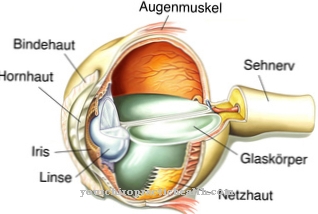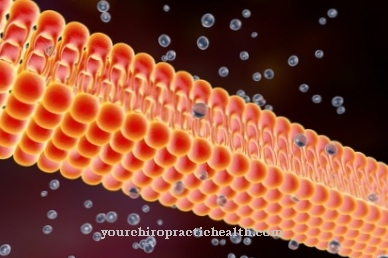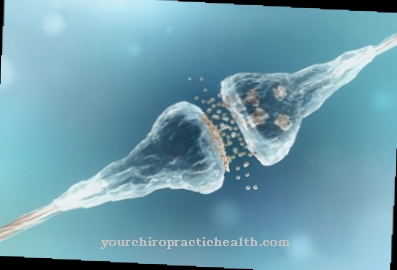The ATP synthase catalyzes the synthesis of ATP. It is a complex of hydrophobic and hydrophilic components.
What is ATP Synthase?

ATP synthase is a transmembrane protein that acts both as a proton pump and as an enzyme for the synthesis of ATP. As a proton pump, it uses ATP to produce energy, while it uses energy to build ATP.
The enzyme consists of 8 to 20 subunits that group together to form two complexes. One complex is insoluble in water and sits within the membrane. This complex transports protons to higher energy levels while consuming ATP. The water-soluble part of the enzyme on the inner edge of the membrane catalyzes the synthesis of ATP from ADP using the proton gradient. The water-insoluble part is called complex Fo and the water-soluble part is called complex F1.
Because of its two subunits, the name is also used for the ATP synthase FoF1-ATPase Application. No other enzyme that synthesizes ATP has yet been recognized. There are many so-called ATPases for this, but they all only use ATP. ATP synthase is the only enzyme that can both consume and synthesize ATP.
Function & task
The ATP synthase plays a key role in the energy metabolism. All energy-consuming metabolic processes are dependent on the energy storage function of ATP. Due to the multitude of metabolic processes, 80 kilograms of ATP are synthesized in the human organism every day and immediately broken down again.
ATP is built up from ADP through the accumulation of a phosphate residue while absorbing energy. This creates a voltage-charged molecule, which would like to give up its energy quickly by releasing the phosphate residue. However, if there were no intermediate storage of energy by ATP, no more metabolic processes would take place.
ATP is universally present in living organisms. This applies to plants, fungi and bacteria as well as to humans and animals. In all organisms, however, the ATP synthase also ensures the formation of ATP. For a long time the mechanism of energy transfer was not clear. The majority of scientists assumed that the energy comes from high-energy intermediate compounds and is transferred to ATP. The British chemist Peter D. Mitchell was the first to postulate that ATP gets its energy from the proton gradient (PH gradient), with ATP synthase playing a major role. This thesis was later confirmed.
According to the researchers' findings, ATP synthesis takes place on the water-soluble part of the enzyme. If a proton is split off in the water-insoluble part of the enzyme within the membrane, the negative charge created during the split-off can be stabilized by an ionic interaction. To do this, the molecule has to twist a little and build up tension. The ATP synthase has now stored energy. When the negative charge is protonated, the molecule snaps back like a tensioned spring and transfers the rotary motion to the outer water-soluble part of the enzyme. There the energy transfer takes place through the uptake of a phosphate residue from ADP, whereby ATP is created. ATP, in turn, is an energy-rich molecule with a high mechanical tension, which releases its energy by releasing a phosphate residue.
The ATP synthase is an inherent part of the respiratory chain and occurs to a large extent in the mitochondria. With the ATP synthase the only ATP-building enzyme was discovered. Without ATP, all energetic processes in the organism would come to a standstill. With the discovery of ATP synthase, the misunderstood connection between NADH oxidation and ATP synthesis was finally cleared up.
You can find your medication here
➔ Medicines for muscle weaknessIllnesses & ailments
In connection with the ATP synthase, diseases can also occur, which mainly manifest as disorders in the respiratory chain. Energy generation in the organism takes place in the mitochondria. There, compounds with a high energy content such as fatty acids or glucose are constantly broken down via the citric acid cycle. As an existentially important short-term energy store, ATP must be constantly formed.
If the ATP synthesis is disturbed, not enough energy can be released. Symptoms such as massive weakness and fatigue occur. The muscles and nervous system are always affected. Since the energetic processes take place in the mitochondria, these diseases are also known as mitochondriopathies.
Malfunctions or damage to the mitochondria are characteristic of these disorders. However, the causes of mitochondrial diseases are diverse. There are inherited and acquired forms of the disease. In inherited mitochondrial diseases, mutations of enzymes are present in the respiratory chain. In the case of an inherited disorder, both the mitochondrial DNA and the DNA from the cell nucleus can be changed by mutations. Of course, among the many enzymes in the respiratory chain, the ATP synthase can also be subject to a mutation.
If the enzyme failed completely, the organism would not be viable. With its limited function, it can be classified in the large group of mitochondrial diseases. The different forms of mitochondrial disease lead to different patterns of symptoms. However, they all have neuromuscular disorders in common. This means that the nervous system and muscles are always affected by the low energy supply. The cardiovascular system and kidneys are often impaired.
Since the energy supply is disrupted, most diseases progress quickly. However, there are no causal therapies, as this is a genetic disease. It is important to increase the intake of energy in the form of carbohydrates and fats as well as to limit energy consumption.












.jpg)



.jpg)










.jpg)
